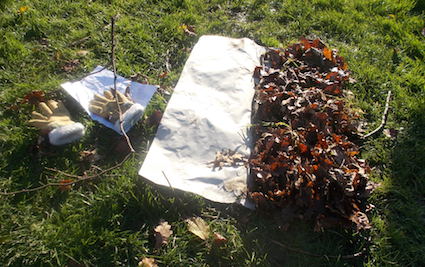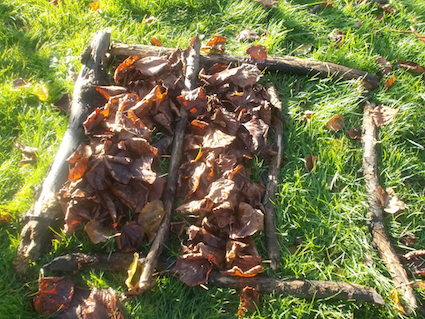One key reason for writing this blog and keeping it going through thick and thin is to provide teachers and early years educators with springboards for their own teaching practice outside. The best things happen when someone reads my blog and then goes on to change an activity to suit the needs of the children with whom they work.
Thus several years ago I was delighted to receive an email from Pete Hubery, Depute Head Teacher at Wensum Junior School in Norwich which read, “Inspired by your fraction wall with sticks post we took Yr3 out today and they did some amazing work. I wanted to email you a photo of one response where two children made a fraction wall by sorting different coloured leaves. Is there any way I can do this?“
Naturally I was curious and excited and Pete kindly sent through the following photos and text:

“The photo of the leaf fraction wall didn’t look quite so impressive on second viewing, but you can make out the whole (brown leaves), halves (yellow and green), and thirds (yellow, red, green). Certainly an innovative solution.“
My response to this, is that the end result rarely reflects the learning which has been undertaken outside when viewed cold. The explanation given by Pete puts the work in context. Outside our work tends to be an approximate representation rather than a centimetre by centimetre accurate diagram. Working with Year 3 children at this stage in their learning about fractions, this representation demonstrates their knowledge and understanding of what they are being asked to do.

“We went out again yesterday (beautiful early December morning) and created more examples of fractions following initial recap in class. This was an outdoor development of a typical shade the fraction worksheet. Fun, smiles, great engagement, and good learning.”
“It certainly improved their understanding as proved when we came back in and a quick shading test resulted in almost 100% correct.”

I think this lesson also demonstrates that perhaps we need to spend time doing practical work even if it takes a little bit more time than a worksheet or desk-based activity and lacks the mathematical precision. The time creating a leaf fraction wall enables children to have thinking time. It also allows time for mathematical conversations that deepen understanding.

However, I’m also interested in how this sort of activity fits into children’s wider learning on a subject. I’ve had mixed results. Sometimes, a lesson outside goes down a storm on the day but then a follow on lesson falls flat on its face. Likewise I’ve had lessons which I felt have been pear-shaped but months on, children recall the lesson accurately and remember all the learning points that were being introduced or reinforced.
What do you think? How successful are you finding your work outside at moving learning on within a subject?
This is an updated blog post of one that first appeared in January 2016.






























I do two lessons a week of practical maths and get outside as often as I can. You’re right, some things go really well and others can fail, but I persevere. Outside, my least engaged students indoors come alive, they thrive and often lead the investigation. These sessions are priceless indicators to their peers that they are good learners too and I’m proud that (even though I’m often the only one out there) I will take a risk to make it more physical and fun. I find sending them off for a sprint first helps them to focus and listen better.
I think the trick is get out little and often so they get used to it.
Thanks for your comment – it’s spot on!